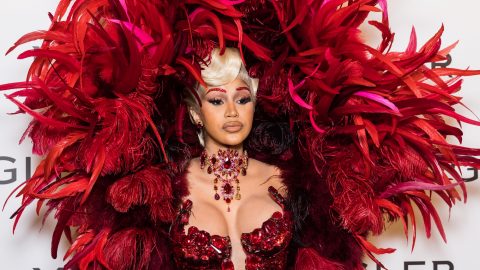
Dora Jar exists at 100mph, whether that’s her career, her schedule, her creativity, or her consciousness. When NME meets her, it’s been less than a week since she performed at Lollapalooza. Her first true festival experience, it was “hectic”, Jar absorbing the energy of the crowd, surprised how many people knew her bizarre yet charming alt-pop. Jar is an ambitious live performer: she was unready ten minutes prior to going onstage – daubing her make-up and tugging on her left boot – and the day’s prop hijinks, a curtain the width of her arm span, which she had originally intended to wheel onstage herself, had been wrongly ordered to five times her size.

“It added to the inner comedy of it!” she says. “I wanted to have a clowning moment; I’ve been very inspired by clowns and commedia and the ridiculousness of it all. When I do something and it gets a reaction, I’m surprised by it, too. The best part of what I get back is presence from the crowd; we’re all just here for this one fleeting moment.”
When it comes to performing live, Jar has had something akin to a baptism by fire. Her debut show was at London’s Waiting Room to an audience of approximately 100 people, one of whom – unbeknownst to Jar – was Billie Eilish, one of the world’s biggest popstars. No stranger to the unusual, Eilish was struck by Jar’s unconventional, fantastical songwriting, charismatic warble, and penchant for a quirk, inviting Jar to support her on the first leg of her ‘Happier Than Ever’ world tour in 2022. In late 2023, she opened for The 1975, ticking Madison Square Garden off her list long before the release of her debut album.
“I’m very interested in things that are confusing, because I felt confused my whole life”
Moments, memories, and the making of it all are important to Jar. She describes herself as an “innate” performer: her mother was a theatrical actor who made up songs on the piano, while her father was a fan of opera and jazz. Jar recalls car journeys soundtracked by Madame Butterfly, Stephen Sondheim musicals, and The Beatles’s ‘Magical Mystery Tour’. When she was born, the family moved from New York City to Northern California to enrol her sister Lueza – who had cerebral palsy – into Neil Young’s Bridge School. It was at the school’s annual benefit concert where Jar, aged four, first saw the Foo Fighters live – an experience she describes as “the genesis of my musical life”.
Jar would perform to connect with Lueza, who died in 2011, and reminisces about her often during our conversation. “I’m the youngest, but it’s an interesting dynamic, because she couldn’t walk or talk,” she explains softly. They were psychically connected, Jar says: “I always had a very kooky, zany inner world and wanted to put on little shows. We took a lot of long car rides when I was a kid, and I would be making up songs, singing to her.” Making Lueza laugh felt like an achievement. “She was a tough crowd but encouraging.”
The kookiness Jar speaks of colours her work to date: a smorgasbord of multi-genre alt-pop that drifts from kitschy, theatrical crooning and intricate, folkish guitar plucking to sludgy experimentalism topped with Y2K melodies. From the mystique of ‘Wizard’ on the 2021 EP, ‘Digital Meadow’, to the underwater loneliness of a mermaid in ‘Lagoon’, from follow-up collection, ‘Comfortably In Pain’, her lyricism conjures fantastical worlds and offbeat characters. Yet on her forthcoming debut album, ‘No Way To Relax When You Are On Fire’, Jar turns her microscope inward and peers into herself.

For someone with such a strong sense of self, it is hard to believe that Jar ever felt lost as an artist. But in her early twenties, she did – a consequence of not releasing her first songs until she was 24 (Jar is now 27). She felt like she “was getting a late start” and put pressure on herself to succeed despite not knowing the music industry. “And I had a lot of frustration and grief from my childhood, and survivor’s guilt about my sister, and I just felt really confused and lost and resentful of things, even though I had so much to be grateful for,” she explains. “There was so much residual aching.”
But then things began to move – and quickly: Jar met her manager; she got playlisted; Billie came to her show; she went on an arena tour. The post-tour imposter syndrome she grappled with was exacerbated by her regard for Eilish, an artist who “broke my mind open again about what music could be”, Jar says, and whose textured worlds helped “shift [her] own realisation of what [she] could do with music”.
“[I was] so confused and I [didn’t] feel like I deserved any of that,” she continues. When her stint on Eilish’s tour ended, she realised she had to write an album. When she looked inside herself, though, she found she didn’t know who she was beyond her pain and her performance. “I felt I skipped a lot of steps and the original wound of what made me depressed, I never really healed that – I became too busy to remember I was grieving and just a squishy human body on this crusty planet.”

Jar decided to start living life so as to answer the question: ‘Who am I?’ She travelled across to Alaska, California, Mississippi – where she learned how to build a mud cob hut; she took mushrooms and did ketamine therapy; she flew to Poland to reconnect with family she hadn’t seen in years and the culture she didn’t grow up around, one devastated by war and the shadow of fascism, but one also imbued with resilience and hope. “Poland helps me connect to history – it puts me in a state of awe, which very much helped my writing process.”
Taking in the language, playing guitar in her father’s ‘old town’ apartment, seeing family for dinner – it wasn’t long before the musical floodgates opened. The first song that emerged was ‘Debbie Darling’, with its soft guitar and off-kilter harmonies. Jar found strength to look her shadow self in the eye, acknowledging her feelings of unworthiness and the perception “that there’s something wrong” with her. At first, the songwriting was daunting: “I forgot that my nature is to be playful. I really detached from that and took so much all of a sudden so seriously.”
She credits an unspecified neurodivergence and a super-active imagination with helping her remember how to play and have fun in creating once more. Jar glances to the top-right of the Zoom call window to emphasise the point. “I’m looking at my dying plant in the corner of the room right now, and it totally looks like a dragon with an open mouth and a ponytail coming out the top of its head. Maybe that would be helpful in a song, or maybe not. Just remembering to play helps propel everything again.”

For Jar, ‘No Way To Relax When You Are On Fire’ encapsulates what she has been through during the two years of creating the project, which has seen her collaborate with everyone from Rostam Batmanglij and The 1975’s George Daniel, to Ralph Castelli [glaive, Blu DeTiger] and Henry Kwapis [Dominic Fike, Matt Champion]. The album’s title feels poignantly loud in an age where a crisis-to-be-averted flits past every doorstep, and fear and anxiety are at a new peak. There are, she says, “so many ways to be on fire: it can be creative, action, hell, heat – good, bad, or both”. On her debut, Jar gives herself permission to be every part of her that arises: loud and happy; sad, or confused.
Her most recent singles capture the chaos with a knowing pep in their step. Made in a three-hour sprint, ‘She Loves Me’ threatens to bolt with an itchy restlessness before slowly drawing to its wiry unravelling, Jar depicting the internal push and pull between the side of her that loves herself and the side that doesn’t. In its music video, directed by Erica Snyder, Jar dances around a Berlin house party between friends and strangers while wearing only a towel: an ode to who she is in public versus who she is alone.
“The music I aim to make is detailed and probably a bit intense… there’s a demanding call to be listened to”
Meanwhile, ‘Timelapse’ – with its dreamy existentialism and Big Apple-inspired humdrum – is a collage of moments documenting her own whirlwind momentum. “‘Don’t stop, jackpot, blacked out, float down’ – that’s literally what happened,” she says. “I kept going, and then I slowly floated down to Earth to meet myself where I was.” On the flip side, the intricate, yearning ache of ‘Ragdoll’ and unrestrained angst of ‘Puppet’ channel Jar’s vulnerability through inanimate symbolism, submitting her agency to the will of others – be it those close to her or the music industry machine.
“I feel like my propensity to be confusing or undefinable comes from me rejecting the idea that I can package myself into a thing that makes sense. The music I aim to make is detailed and probably a bit intense; whether it’s a lullaby or upbeat, there’s a demanding call to be listened to.” Jar says she plays ideas over and over until her ears prick up. “I’m very interested in things that are confusing, because I felt confused my whole life.”

Her favourite song on the album is ‘Behind The Curtain’, partly in its use of a Vanguard, a machine that helped her sister to communicate, and partly because it reminds her of The Wizard Of Oz with “this big, mean, terrible wizard yelling at these poor little guys, and then you look behind the curtain [and] it’s just a scared, insecure man pulling levers”. “I often relate to both sides,” Jar adds. “And then realising that, anytime I feel the need to prove myself, it’s usually coming from an insecurity that hasn’t been worked out.”
Years of introspection and escapism, be it creative, spiritual, or mindful, have helped Jar throughout her life. She recalls a trip on psychedelic mushrooms at a time when she was still vividly pained with grief, her elevated consciousness informing her that she was “performing all the time”. Jar realised she was living a lie. “When you can’t share what you’re going through with others, you can’t connect, and no one can share with you; it’s like a repelling magnet.”
Time and again, music and imagination has saved Jar – but who is she now?
“There is no conclusion. Even when you die, there’s no conclusion,” she says, no closer to an answer, albeit seemingly more at peace with that than before. “You still are, were, and will be an ever-changing, meaningful expression of life.”
Dora Jar’s ‘No Way To Relax When You Are On Fire’ is out September 13 via Island Records.
Listen to Dora Jar’s exclusive playlist to accompany The Cover below on Spotify and here on Apple Music.
Words: Kayleigh Watson
Photography: Kristen Jan Wong
Styling: Keyan Miao
Hair: Nevada Raffaele
Makeup: Morgan Grimes
Label: Island Records
The post Dora Jar faced her shadow self and remembered how to play appeared first on NME.






